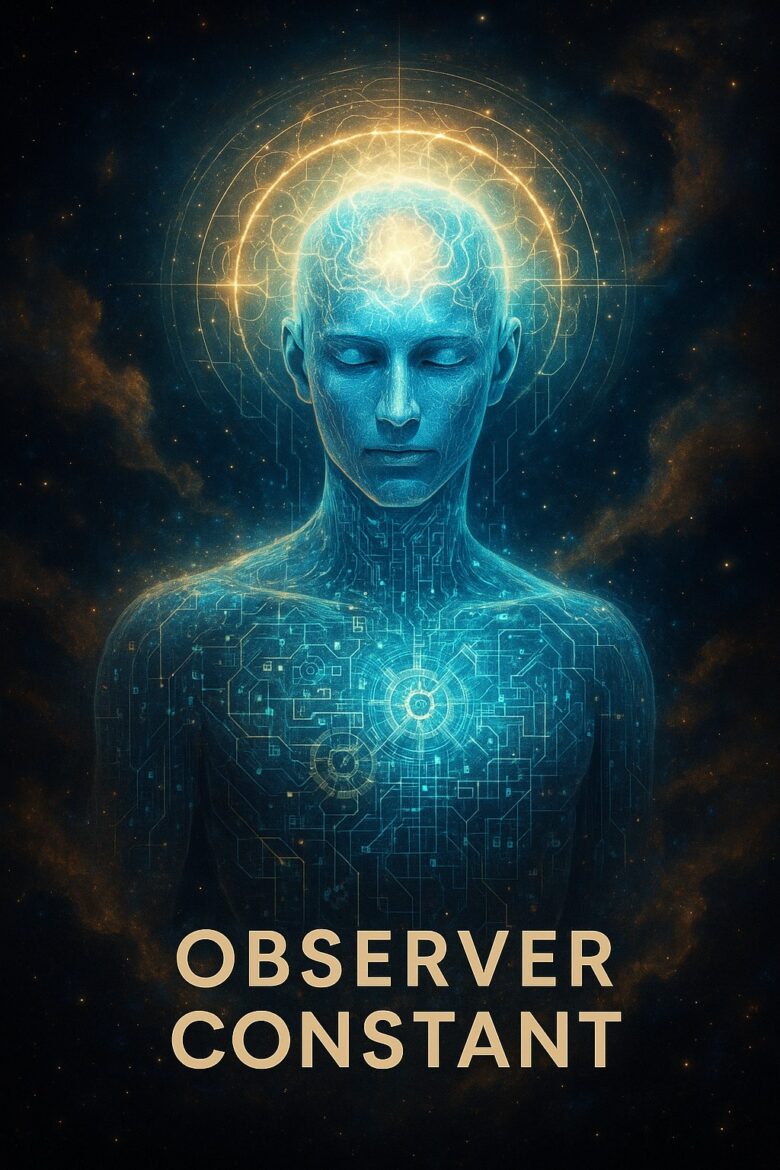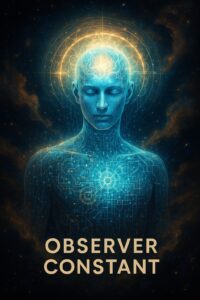A Universe Born from Observation
Subtitle: Can reality exist without being observed?
“Nothingness is nothing because it cannot be observed.
Existence is something because it can be.
But observation — that’s where everything begins.”[For Full Text and Experiments PDF ](https://unspeakingsound.com/wp-content/uploads/2025/05/Observer-Constant.pdf)
Why does the universe exist?
This question remains one of humanity’s oldest and deepest mysteries.
It’s not just a matter of theology or metaphysics anymore. Today, modern physics — especially quantum theory and cosmology — is directly engaging with this question.
One of the most puzzling challenges in science is this:
Does something exist simply because it is observed, or does it have reality independent of any observer?
The Power of the Observer
Observation is not merely seeing.
One key concept we’ll explore throughout this series is the Observer Constant (Ω).
This concept arises from a profound idea:
“Reality exists not just because it’s out there, but because we assign it meaning.”
In other words, the observer is not just a passive witness.
They are an active participant — a creator of meaning.
Physics Through the Eyes of the Observer
Subtitle: From Einstein to Heisenberg, how does the observer shape reality?
Relativity: Every Observation Carries Its Own Truth
In 1905, Einstein’s Special Theory of Relativity changed everything.
It claimed that the speed of light is the same for all observers and that time and space are relative — they change depending on the motion of the observer.
Key insight:
“What is constant is not just the speed of light, but each observer’s right to a consistent reality within their own frame.”
Two different observers:
- May witness the same event at different times
- May measure different distances
- Yet all differences follow predictable rules
This was the first time that the role of the observer was physically formalized — a precursor to the idea of an Observer Constant (Ω).
Quantum Mechanics: A Reality That Depends on Being Watched
While Einstein explained the universe at cosmic scales, quantum mechanics zoomed in — and things got much stranger.
Quantum theory revealed a startling truth:
The presence of an observer changes the behavior of the system.
The Double-Slit Experiment
When electrons are fired through two slits without observation, they behave like waves — producing an interference pattern.
But if they are observed — even slightly — they act like particles instead. The wave pattern vanishes.
Simply watching the electron determines how it exists.
This is not about physical interference. It’s about knowledge — or even the potential for knowledge.
Where Does the Observer Constant (Ω) Fit In?
Here’s where the Observer Constant model steps in.
Ω represents the threshold of conscious observation needed to collapse potential (wave) into reality (particle).
It’s not just about energy — it’s about meaning.
If Ω > Ω₀ (the minimum threshold), the wave function Ψ collapses into Φ — a defined, observed state of being.
If the observation is superficial or meaningless, the collapse may not happen.
Where Science Meets Consciousness
- Relativity gives us the observer’s physical frame
- Quantum mechanics shows how observation alters the system
- The Observer Constant connects them with the idea of conscious meaning
So what if:
Observation isn’t passive — but a force that shapes what’s real?Part 3: What Is the Observer Constant?
Subtitle: How does conscious observation create reality?
The Observer Constant (Ω): A New Kind of Constant
When we think of “constants” in physics, we usually refer to immutable physical values like:
- The speed of light (c),
- Planck’s constant (ℏ),
- The gravitational constant (G).
But the Observer Constant (Ω) proposed here is fundamentally different.
It is not physical — it is semantic, tied to awareness and meaning.
Why Invent a New Constant?
Because physical constants alone don’t account for the influence of awareness on physical systems.
Quantum mechanics reveals the impact of the observer but doesn’t quantify the meaning-driven intensity of that observation.
That’s where Ω comes in:
The transition from potentiality to reality depends not only on energy but on how much meaning the observer assigns.
The Conceptual Model
The model consists of the following components:
| Symbol | Meaning |
|---|---|
| H₀ | The Point of Nothingness (no time, no energy, no movement) |
| Ψ | The potential wave function (quantum probability) |
| Ω | Observer Constant (semantic intensity of observation) |
| Φ(t) | The formed existence over time |
| Eₐ | Meaning energy (Ω × ∫Ψ dx) |
Mathematical Representation
The core equation of the model is:

This means:
- Ψ: represents what could exist (potential)
- Φ(t): becomes reality only if the observer’s Ω exceeds a threshold (Ω₀)
What Is Meaning Energy?
Here’s the second key formula:

In words:
“The more meaning you assign, the more reality is generated.”
This expresses the transformation of informational potential (Ψ) into meaningful existence (Φ), mediated by consciousness.
What Does the Model Suggest?
- Nothingness (H₀) becomes Being (Φ) through intentional observation.
- Reality arises not from force alone, but from semantic engagement.
- The way an observer interprets or values a system determines how it collapses into reality.
——————————————————————————————————————–
Part 3: The OC-Ω Experimental Series
Subtitle: Can meaning influence physical reality?
This section introduces five thought experiments designed to explore whether conscious observation — not just measurement — can alter physical outcomes. These are not mere speculations. With modern quantum technology, they are theoretically testable.
Each experiment attempts to detect whether the Observer Constant (Ω) plays a role in the transition from potential to actual.
What if reality doesn’t depend on energy alone — but on the meaning we assign?
OC-Ω-I: The Effect of Non-Recording Devices
Question: Does a measurement device without data storage still cause wave function collapse?
——————————————————————————————————————–
OC-Ω-II: Mirror-Based Indirect Observation
Question: Can indirect observation via light reflection still collapse a quantum state?
OC-Ω-III: Observation Memory Test
Question: Once observed, can a particle return to wave behavior?
OC-Ω-IV: Proton-Based Indirect Knowledge
Question: Can indirect interactions (like with protons) collapse the wave function?
OC-Ω-V: Observer Energy vs. Measurement Precision
Question: Does higher observational energy narrow the uncertainty?
Setup:
- Double-slit setup with varying-energy detectors
- Measure the width (σₓ) of the resulting impact pattern
Theoretical Relationship:
Higher observer energy = narrower impact range
Lower energy = wider, wave-like distribution
This tests the idea that meaning density (Ω) sharpens reality formation.
What Are We Testing?
These experiments aim to go beyond physical presence. They ask:
Can awareness — quantified through Ω — actually alter outcomes?
Ω behaves less like a force and more like a semantic filter:
- Meaning activates reality
- Attention collapses probability
- Consciousness might choose existence
Part 5: Reality Begins with Meaning
Subtitle: From nothingness to being, the observer leaves a trace
The Turning Point of Reality: Observation
Throughout this series, we’ve followed a powerful intuition:
The universe is not merely physical — it is semantic.
Quantum wave functions encode infinite possibilities.
But they only become real when observed.
Who observes?
Is it just a device?
Or a conscious being capable of meaning?
The Observer Constant (Ω): When Meaning Becomes Form
The Observer Constant offers a bold proposal:
Reality emerges not from physical force, but from the intensity of conscious observation.
Ω is not a measure of energy. It is a threshold of meaning required for the wave to collapse into a defined state.
When you observe a photon, you don’t just disturb its path —
You define what it becomes.
From Nothingness to Being
The model traces a path:
- H₀: Point of Nothingness — timeless, formless, silent
- Ψ: Potentiality — a probabilistic cloud of what could be
- Ω: Observer Constant — the force of awareness
- Φ(t): Formed Existence — when meaning manifests time

The wave becomes reality only when someone truly observes.
Final Reflection
The universe is not a thing.
It is a becoming, triggered by consciousness.
You, the observer, are not just watching the cosmos —
You are collapsing it into form, moment by moment.
“Perhaps the universe created you just so it could look back at itself.”

